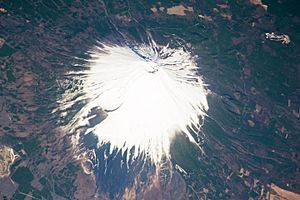Jōgan facts for kids
The Jōgan (貞観) era was a period in Japanese history. It came after the Ten'an era and before the Gangyō era. This time lasted from April 859 to April 877. During the Jōgan era, two emperors ruled Japan: Emperor Seiwa and Emperor Yōzei.
Important Events of the Jōgan Era
- In 859, the first year of the Jōgan era, New Year's celebrations were stopped. This was because the country was mourning the death of the previous emperor, Emperor Montoku.
- In 864, Mount Fuji erupted for 10 days! Hot ash and cinders fell far away, even reaching a place called Kai Province.
- In 869, Prince Sadaakira was born. He would later become Emperor Yōzei.
- On July 9, 869, a big earthquake and tsunami hit the Sanriku coast near Sendai. This caused a lot of damage.
- In 870, Prince Sadaakira was chosen to be Emperor Seiwa's heir, meaning he would be the next emperor.
- In 876, Emperor Seiwa decided to step down from his role as emperor. His five-year-old son, Prince Sadaakira, then became the new emperor. This was made official with special ceremonies.
During this era, a collection of laws was published. It was called the Jōgan kyaku-siki. These laws had been put together since 811.
Related Pages
Images for kids
See also
 In Spanish: Jōgan para niños
In Spanish: Jōgan para niños

All content from Kiddle encyclopedia articles (including the article images and facts) can be freely used under Attribution-ShareAlike license, unless stated otherwise. Cite this article:
Jōgan Facts for Kids. Kiddle Encyclopedia.


